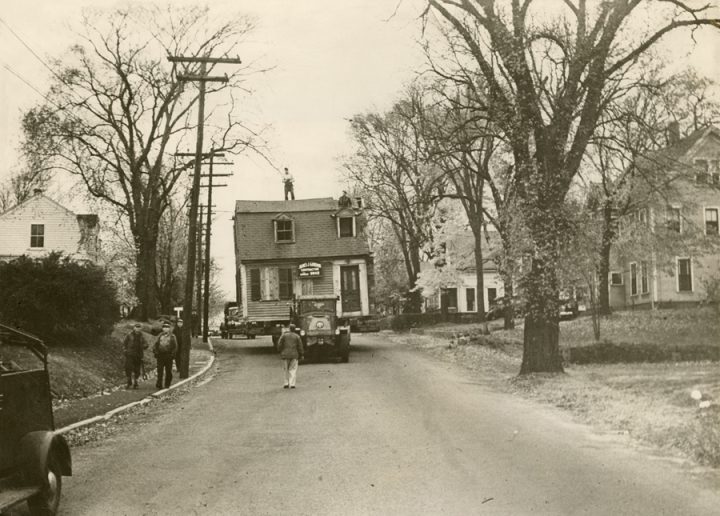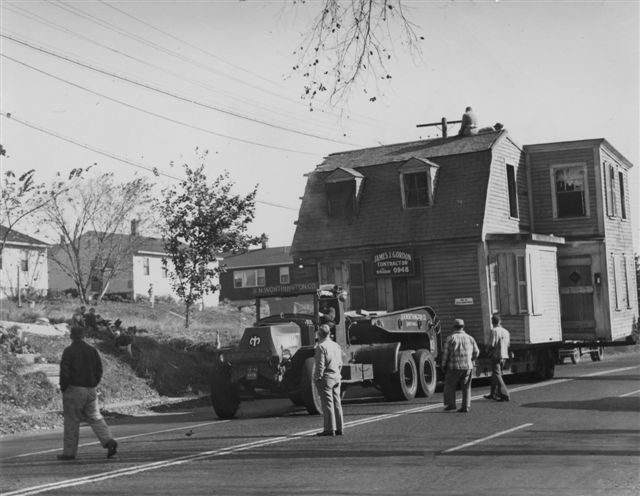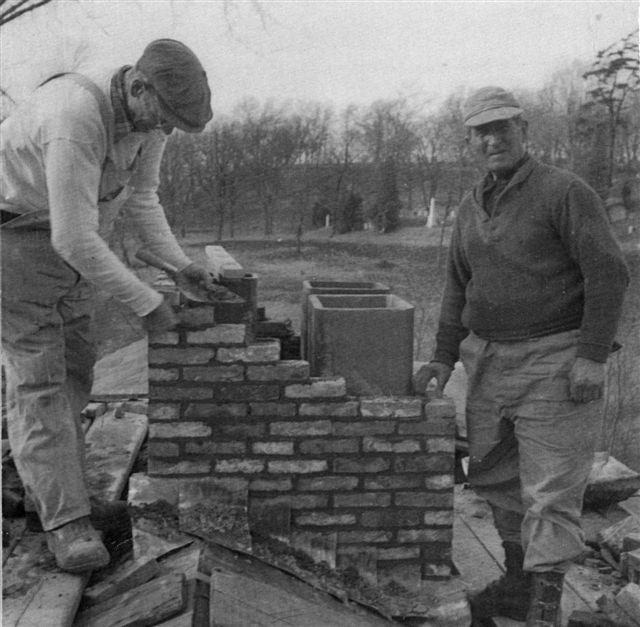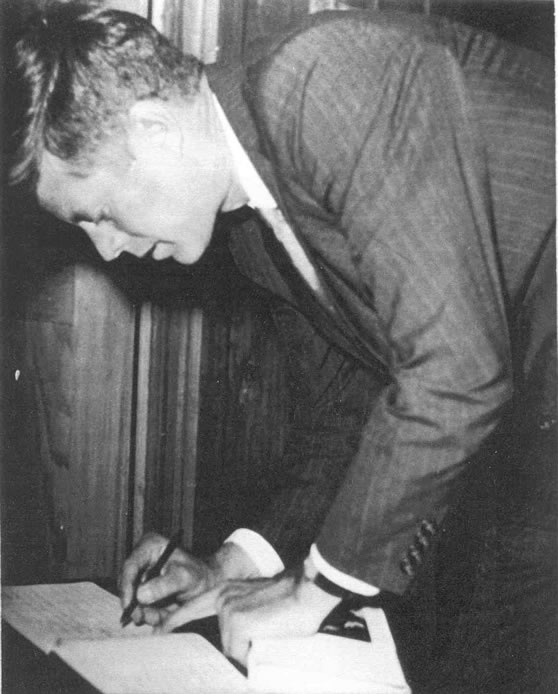1947 Restoration
On the Verge of Demolition
At its location on Bridge street in North Weymouth, through the years the birthplace was occupied by various tenants until 1947 when the land and the building was acquired by the federal government in order to build federal housing. All of the farm’s buildings were marked for demolition. At this point, a small group of Weymouth residents, aware of the historic value of the birthplace, began strenuous efforts to save it. In 1947 Weymouth residents formed an association to save the house, threatened for demolition. The group incorporated as The Abigail Adams Historical Society and the building was moved without delay.
The women and men who formed the Abigail Adams Historical Society grew up in the golden age of building restoration, the first four decades of the 20th century, when dozens of houses across Massachusetts were restored, often quite severely, to some earlier point in their history. The results were dramatic, especially in the case of First Period houses like this, but sometimes not very true to the history of the building. In the decades since, a much more conservative preservation policy has prevailed, in which many of the layers of later additions are preserved.


The Birthplace is Moved
On May 1, 1947, the Town of Weymouth released a triangular lot of land at the junction of North and Norton Streets for the sum of one dollar. A foundation was laid, and in October of 1947 the old house, sawed squarely in half, was moved to its new site close to its 1685-1838 location. The two sections were joined so skillfully that no trace of this operation appears in the house today.
The house was in a sorry condition and it was necessary to strip it to the frame in order to restore it, following the recommendations of Frank Chouteau Brown, an architectural historian. A central chimney, with four fireplaces and a “bee-hive” oven in the kitchen, was rebuilt. The paneling in the two front rooms came from a distinguished old home in Braintree; and the kitchen beams and wall panels were from a Hingham tavern.
The furnishings and articles of daily living seen in the house date to the period of Abigail’s residence and serve to illustrate what life was like in the mid-eighteenth century. The 1947 restoration had officially begun.
The 1947 Restoration of the Abigail Adams Birthplace
The 1947 restoration of the Abigail Adams Birthplace was a multi-year collaborative work by several designers and craftsmen: noted restoration architect and author Frank Chouteau Brown, muralist and architect Carroll Bill, artist and landscape architect Theron I. Cain, and four craftsmen experienced in restoration work: contractor James Gordon, masons Frank Osborne and Charles White, and carpenter Charles Peaselee.
Although the two moves and complicated history of the building make it difficult to absolutely prove its age and original form, the Abigail Adams Birthplace is undoubtedly important as a restoration of a First-Period structure planned by Frank Chouteau Brown and carried out by a group of designers and craftsmen passionately interested in honoring his principles in achieving their goals.

A Deliberate Approach Towards the Restoration
In the detailed reports Edwin A. Hoadley filed as chair of the restoration committee, the deliberation and conservative approach the committee employed in restoring the Adams Birthplace become evident. Craftsmen who had worked on other restoration projects were carefully chosen to undertake the work. James J. Gordon of Hingham oversaw the moving, with the house cut in half and carted southward in two sections. He served as contractor for the long process of restoration, employing masons Frank Osborne and Charles White and carpenter Charles Peaselee (d. 1955). White and Peaselee were both residents of Hingham. Peaselee had considerable restoration experience and old-fashioned hand tools which he employed in the restoration. In one report Hoadley documents White’s restoration masonry, listing architects and projects, including the Old Ordinary in Hingham on which White worked.
Decisions were made on an individual basis. Decaying items like sills were carefully tested to see if they could remain in place with bracing. The restoration principles of the time dictated that the age of any replacement materials was almost as important as provenance. The restoration includes foundation stones from the ell’s Bridge Street site, doors from a house-wrecking in Quincy, three thousand old bricks from an old house in Newburyport, 1100 old hand-wrought nails from Boston, floor boards from old Fort Independence in South Weymouth, kitchen beams and panels from a tavern in Hingham, other bricks from streets around the Old North Church in Boston, and sockets for the fireplace cranes salvaged from the ruins of a recently demolished house in Lovell’s Corner, Weymouth. Age and style were so important that two doors which previously had been installed were removed and replaced when it was discovered they dated from the 1790s rather than 1744, the date to which Brown had suggested restoring the house. Another association member did a title study to confirm the age of the Malvena Tavern in Braintree, whose paneling was found the right vintage for use in the Adams Birthplace restoration. Still other elements were copied directly from surviving details and manufactured new for the restoration: clapboards by Rhines Lumber Company and window frames by Sward Brothers, based on the single dormer window in Abigail’s room. Hugh Burgess turned by hand the balusters for the staircase. Hoadley documents a trip he made to South Wareham with Brown, down a dirt road, to investigate salvaging an old barn for the site. Hoadley became an expert on ovolo mouldings, ogees, and quirks. While on vacation Hoadley visited the Egremont Tavern restoration (ca. 1730) in South Egremont, Massachusetts. The rear saltbox addition to the gambrel roof of the Adams Birthplace was made only after painstaking investigation of the frame, careful reading of Brown’s suggestions, and a search for other examples.
The 1947 restoration would create a space where visitors can be immersed in an important part of this nation’s history. It wouldn’t be until 2012 that the modern restoration of the Abigail Adams Birthplace would occur.

Support for the Birthplace
While Carroll Bill directed the restoration under Hoadley’s watchful eye, the public face of the organization was its President Amy Hill Duncan, a Weymouth activist and newspaper columnist. She organized a “clean-up” of the house on Bridge Street by advertising that Life magazine photographers would cover the event and lining up a fiddler to play “Turkey in the Straw” and waltzes to entertain the workers. The dedication of the site on July 13, 1947, included guest speaker Stewart Mitchell, executive secretary of the Massachusetts Historical Society and editor of a volume of Adams letters; and the widow of telephone pioneer and Old North Cemetery occupant Thomas Watson. She saw to it that all the area newspaper photographers captured images of the severed halves of the house parading down North Street to their new home. She approached the railroad executives and convinced them to allow her to open an Abigail Adams thrift Shop in the basement, the former coal room, of the Weymouth Heights Railroad Station in 1948. A natural culmination of this publicity campaign was the 1951 solicitation of bricks from all the surviving first ladies, resulting in bricks from the Mrs. Coolidge, Roosevelt, Truman, and Wilson being used in the hearth of Abigail’s room.


A Visit by JFK
Two further items might show how iconic the Adams House restoration has become. By 1958, it was natural for an aspiring politician such as Senator John F. Kennedy to visit the Abigail Adams Birthplace for a photo opportunity. The association still has the autographed copy of Profiles in Courage that Kennedy presented to them on his visit. In 1970, Gertrude Vaughan hired architect Peter Worden to build a replica of the Adams Birthplace house on a lot she owned in Harwich on Cape Cod. Given the current national resurgence in interest in John and Abigail Adams, the history of the birthplace of Abigail Adams, the country’s “first Second Lady and second First Lady,” is increasingly important to document and register.
Sources
[1] Withey, Henry F., and Elsie Rathburn Withey. Biographical Dictionary of American Architects
(Deceased). Los Angeles: New Age, 1970.
[2] Kevitt, Chester B. Weymouth, Massachusetts, a New England Town. Weymouth: N. p., 1981. p.123
[3] Kevitt, 123
[4] Ask Art Online